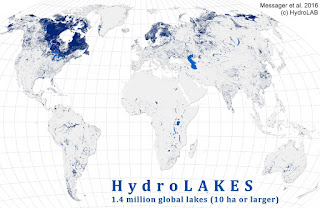I've been writing a couple of water-related things this month, including the China piece that just came out, and another feature I'll submit this week. These reminded me of last year's feature on the vanishing lakes - water management failures so big you can spot them from space and have to redraw maps to account for them. Kind of an early warning system for all the water challenges we're facing. Out in the open now:
The world's vanishing lakes

This map shows the world’s lakes with surface areas of 10 hectares or more. The large, dark blue areas in Canada reflect the high concentration of lakes in those regions. (Image: HydroLAB, McGill University.)























